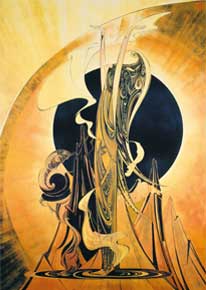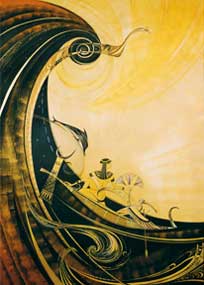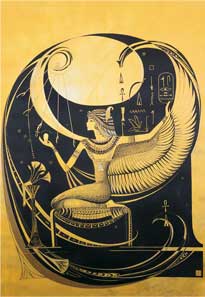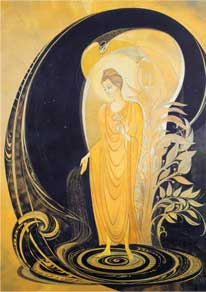| printer friendly | |||
|
|||
The hall-prelude, hall-epigraph, in the oval blue space of which a mountain crystal is shimmering mysteriously. For a moment the crystal goes out, as if standing still in silence, and the next moment solemnly flashes up with glowing rays. This is how human heart pulses merging in a single beat with the rhythm of the planet, the rhythm of Cosmos.
|
|

|
|
|
N. Volkova. Ruin of Atlantis. 1997 |
And surrendering to this cosmic rhythm, one after another, amazing images arise before us, charming with their lightness and subtlety. Transparent figures, as if woven from golden rays; mysterious symbols concealing in themselves a “vague guess of the future of the mankind” (K. Tsiolkovsky); a spiral uniting in its impetuous movement all the canvases and disappearing into the depth of the Infinity.
As if “illuminated by other worlds” (P. Florensky), our reality, our past, present, and future arise in front of us. The symbolic images on the painter’s canvases represent stages of the spiritual and cultural evolution of mankind, the ideas of which found embodiment in the philosophy of cosmic reality brought to the world by the Roerichs.
The first painting refers us to the distant past of the planet. The legend of Atlantis’ collapse is coming back to life on it.
Inhabitants of a beautiful country, having reached unusual heights in their development, forgot about the Great Laws of Cosmos, lost their link with the spirit, with the Divine element. Living “in the name of themselves”, they stepped on the way of destruction – and breaking through waves of chaos flooded Atlantis.
The black disk of darkness covered the shining sun. The last peaks are submerging into the profound depths of the ocean. But the Spirit sparkle is immortal, love and beauty are not subject to destruction, the flame of knowledge must not fade away. Inspired prayer upraises the priestess slender figure. In her sacrificial oblivion she surrenders to heaven, and the future is revealed before her inner sight…

|
|
| N. Volkova. Aphrodite’s Birth. 1997 |
|
A powerful wave, the last echo of the subsiding element, in its impetuous movement brings out onto the ocean surface a light bark. A young girl, “the light daughter of the dark chaos” (V. Soloviev), like a goddess born from the sea foam, directs the bark joyful run. The sacred bird ibis – the symbol of wisdom – looks into the distance. A playful dolphin follows the bark asserting continuation of life. From the crest of the wave, a kingly dragon is looking down dispassionately, symbolizing the start of a new turn in the endless spiral of cosmic evolution of mankind.
The new beauty and the new world of the earth culture are presented on the artist’s next painting. We see a symbolic image of Ancient Egypt, the high culture of which succeeded to the atlantes’ vanished culture.
Surrounded with ancient symbols, a beautiful priestess is sitting high in a radiant sacred circle. Her head is crowned with a diadem bearing the sacred serpent – the symbol of wisdom and possession of high knowledge. An ostrich plume of Goddess of Truth Maat, the symbol of fragility of our world balance and harmony, is decorating her hair. One of the sun rays is blessing the priestess and handing to her the key of eternity ankh, another one touches the credenza, and a beautiful lotus opens on it.
|
|

|
|
|
N. Volkova. Ancient Egypt. 1997 |
Ancient Egypt is a page in the early history of mankind which is more like history of the heaven than that of the earth. The ancient man sensed his inalienable integrity with the Cosmos, with the planet on which he lived, with the nature that surrounded him. He cognized the world as a single whole, in all its integrity, as a tireless thinker, as a keen scientist, and a subtle artist. Integral cognition of the world, full of images, resounded in him with myths and mythological images. Those images were multi-faceted, complicated, but behind them there was always reality – that reality towards cognition of which the man was moving.
Knowledge lies in the basis of the mankind evolutionary advancement. And in all its history, despite various deviations and distortions, knowledge was appreciated most of all. Devine teachers and cultural heroes of myths, wizards and ascetics, Teachers of the mankind for hundreds of centuries, brought to the world spiritual knowledge, illuminating the mankind’s way to the future with the light of truth.

|
|
|
N. Volkova. Buddha and the Heavenly Ganges. 1997 |
|
About 2.5 thousand years ago, Great Indian Teacher Gautama Buddha gave to the world the teaching of perfect structure of life, told about the laws of great matter and the world evolution.
Symbolically subtle and beautiful image of Buddha arises before us on the artist’s painting. The golden hood of cobra above his head – the symbol of transformation, the sign of the spirit’s victory over the solid matter – testifies to enlightening, achievement of the higher knowledge and wisdom. Like a blessed flow from the Teacher’s palm, his Teaching, full of endless love and compassion for people, pours out into the world.
The reason for all human suffering, Buddha asserted, is ignorance, for it makes us appreciate what is not worth it, suffer where there should be no suffering. Ignorance is a greatest crime for it makes us spend life in pursue of trifle values, ignoring what is in fact the most valuable – the knowledge of the mystery of human being and fate.
Man is part and reflection of Cosmos, Buddha taught, and same like Cosmos, is unrestricted in terms of his possibilities. Our lives are consequences of our thoughts, words, and actions. Hence comes the colossal responsibility of man to all, and first of all – to himself. Real progress, evolution can only be achieved through personal efforts, by way of actual conscious labor and self-development.
Buddha influenced the people around him with his life itself, with the example of his personal labor, and this was the reason of his influence power.
Predecessor of many modern scientists in many areas of knowledge, Buddha stated that the whole Universe exists only due to its energies interaction. Nothing exists beyond collaboration. Established by him communes brought up people who were courageous, fearless, full of high aspirations and love for man. Buddha bequeathed the world commune as the humanity evolution.
They called Buddha the “Lord of the Wheel of the Good Law”, the “Lion of Law”. Having indicated the evolution goal as conscious collaboration with Cosmos and communication with distant worlds, the Great Indian Teacher showed the mankind the way for its whole existence.
|
|
||
|
||
